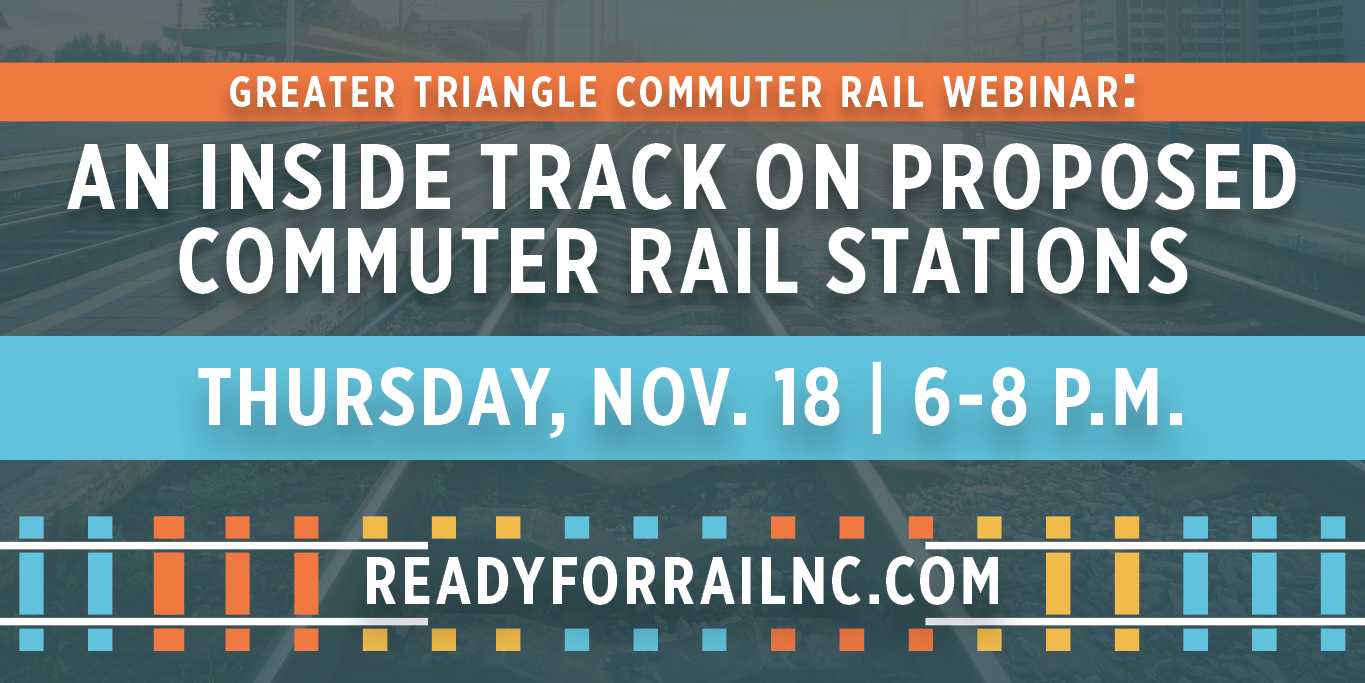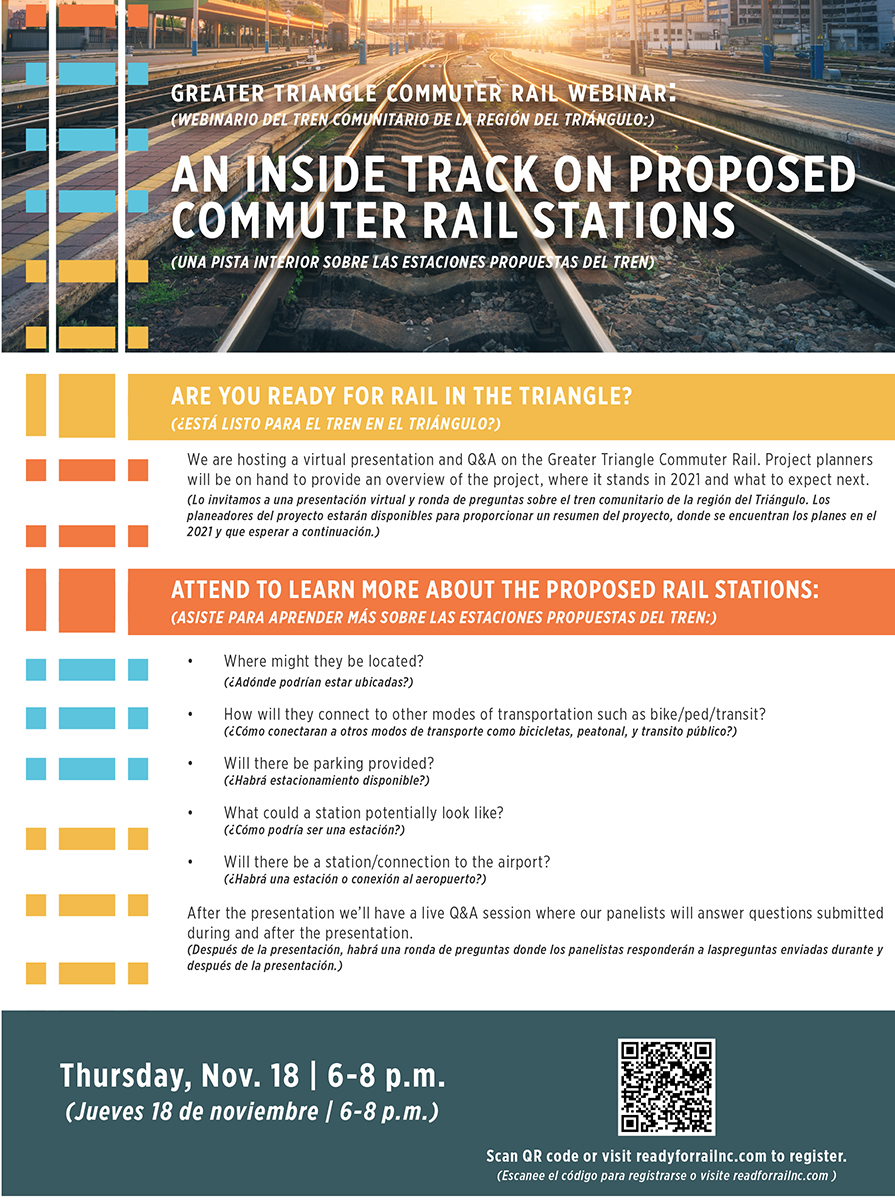Get Inside Track On Triangle Commuter Rail At GoTriangle Virtual Event
 To help keep the community up to date about what’s happening with the Greater Triangle Commuter Rail Project, GoTriangle is hosting a virtual presentation and Q&A session from 6 to 8 p.m. on Thursday, Nov. 18.
To help keep the community up to date about what’s happening with the Greater Triangle Commuter Rail Project, GoTriangle is hosting a virtual presentation and Q&A session from 6 to 8 p.m. on Thursday, Nov. 18.
Project planners will be on hand to provide an overview of the project, where it stands in 2021, and what to expect next. Sign up here to attend the Greater Triangle Commuter Rail: An Inside Track on Proposed Commuter Rail Stations event.
“As we continue to move forward with the last study phase of the Triangle’s commuter rail project we know the community has questions about what the project might look like and what happens next,” GoTriangle President and CEO Charles Lattuca says. “We asked those who have signed up to be Commuter Rail Insiders at readyforrailnc.com what they’d most like to hear more about, and we’ve designed an event for the general public around those answers. This project is essential to helping the ever-growing Triangle maintain its renowned quality of life, and we’ll be prepared to answer questions live at the event as well.”
The presentation will cover:
- Where stations might be located.
- How they will connect to other modes of transportation such as bike/ped/transit.
- Where parking will be provided.
- What stations could potentially look like.
- How the commuter rail line will connect passengers to Raleigh-Durham International Airport.
 After the presentation, GoTriangle will offer a live Q&A session where our panelists will answer questions submitted during the presentation.
After the presentation, GoTriangle will offer a live Q&A session where our panelists will answer questions submitted during the presentation.
Panelists include Katharine Eggleston, chief development officer at GoTriangle; Jay Heikes, senior transportation planner at GoTriangle; and Monica Barrow, transit planning practice leader at STV, the major consultant on the project.
In spring 2020, a Memorandum of Understanding was signed by GoTriangle, Capital Area Metropolitan Planning Organization, Durham-Chapel Hill-Carrboro Metropolitan Planning Organization, Wake County, Durham County, Johnston County, and the North Carolina Railroad Company that named GoTriangle as the sponsor for the Greater Triangle Commuter Rail Project.
The project, part of long-range transit plans in Wake and Durham counties, will run at least 37 miles in the NC Railroad corridor from West Durham through Raleigh to Garner or Clayton. Stops will include downtown Raleigh, N.C. State University, Cary, Morrisville, Research Triangle Park, and downtown Durham.
The Greater Triangle Commuter Rail Project will provide residents a quick and reliable commute, increase access to opportunity and serve as an economic development driver even as 600,000 more people join the Triangle over the next two decades or so.
No matter how crowded the Triangle’s roads get, commuters will be able to rely on the rail line to get them to work, school, health care or play in the same amount of time every day. Instead of gripping a steering wheel, commuters can read, work, sleep, check social media and relax.
Commuter rail lines also are more environmentally friendly and offer local governments the opportunity to create affordable housing near station areas for residents who also benefit by spending less money on owning vehicles.
A recent Triangle J Council of Governments study found that 27% of the region’s available Legally Binding Affordable Housing is within a mile of the rail corridor, while the corridor itself makes up only 4% of the region’s land area.
In Durham, 37 percent of the county’s LBAR units are within a mile of the rail corridor.
There also are many opportunities to build more affordable housing. There are plans for 2,000 new affordable homes in downtown Durham alone. The rail project would serve this area of density and help scores of people with modest means reach job centers, the study found.
“More than 40,000 households in the Triangle metro region have no car available,” says Charles Lattuca, president and CEO of GoTriangle. “Fortunately, the Greater Triangle Commuter Rail Project would be the spine of our regional transit network that also will include several connected bus rapid transit projects and an expansion of bus service. Together, these projects will open up an amazing amount of access to opportunities for everyone across the Triangle.”


